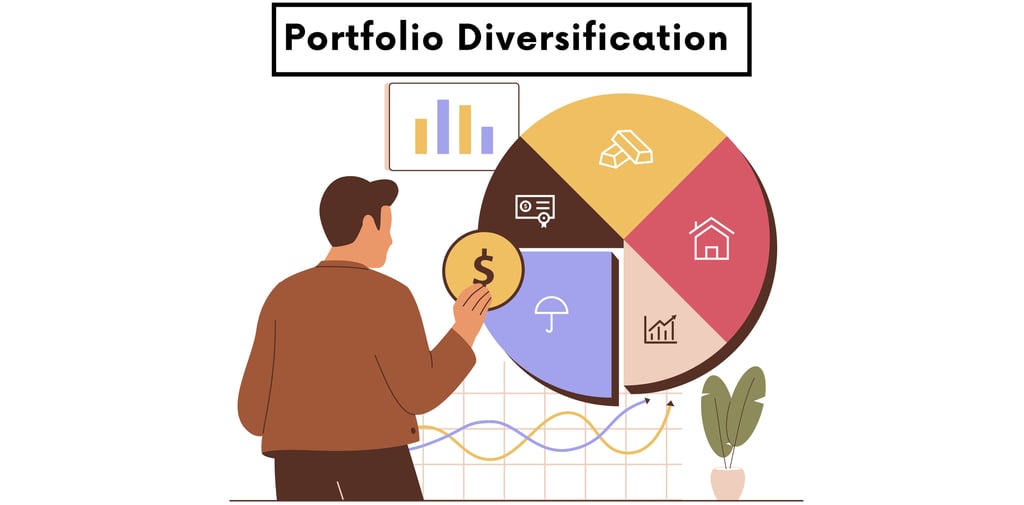Portfolio Diversification Strategies: Building a Balanced Investment Approach


INTRODUCTION
The stock market is full of opportunities — but it’s also full of risks. Every investor knows that not all investments go up at the same time, and sometimes, even good stocks fall due to external events. That’s where portfolio diversification comes into play. Diversification is one of the oldest and most reliable strategies in investing. It helps reduce risk, smooth out returns, and protect your capital from being too dependent on one asset, one sector, or one market. In this blog, we’ll break down what diversification means, why it matters so much, and how you can apply simple yet powerful diversification strategies to your investment portfolio.
What Is Portfolio Diversification?
Portfolio diversification is the process of spreading your investments across different assets, industries, or markets to reduce the overall risk. The basic idea is simple. If one investment performs poorly, others may perform better and offset the losses. By avoiding concentration in a single stock or asset class, diversification creates balance and stability in your portfolio. It doesn’t guarantee profits, but it greatly reduces the chance of large, unexpected losses.
Why Diversification Is Important
Markets are unpredictable. A single stock, no matter how strong, can be affected by company-specific news, regulation, competition, or market sentiment. Similarly, entire sectors or economies can go through downturns due to political, economic, or global events. Diversification helps investors avoid the danger of putting all their eggs in one basket. It provides a safety net that helps preserve capital and improve long-term performance. Studies have shown that diversified portfolios tend to have more consistent returns over time compared to concentrated ones. Even professional fund managers spread risk across various holdings.
Types of Diversification
There are several ways investors can diversify their portfolios. Let’s look at the key types:
Asset Class Diversification
This involves investing in a mix of different asset types such as equities, bonds, real estate, gold, and cash equivalents. Each asset class responds differently to economic conditions. For example, when stock markets are falling, bonds or gold often hold up better. By combining multiple asset classes, you create a portfolio that is less sensitive to the performance of any one category.
Sector Diversification
Within the equity portion of your portfolio, you can diversify across different industries or sectors such as technology, banking, healthcare, energy, and consumer goods. If one sector experiences a downturn, other sectors might continue to perform well. Sector diversification helps you manage risk that comes from economic cycles or industry-specific events.
Geographic Diversification
Investing across different countries or regions adds another layer of diversification. It protects your portfolio from risks tied to a single economy or political system. For example, if India’s market faces a slowdown, your exposure to US, European, or emerging market stocks might help balance your returns. Global diversification has become easier today thanks to international mutual funds and ETFs.
Time-Based Diversification
Also known as rupee-cost averaging, this involves investing regularly over time rather than putting all your money into the market at once. This strategy reduces the risk of entering the market at a high point. By spreading your investment across different periods, you benefit from market ups and downs without trying to time them perfectly.
How to Build a Diversified Portfolio
The first step is to understand your risk tolerance, investment goals, and time horizon. A young investor with a long-term horizon may invest more in equities, while a retiree may prefer more bonds or fixed income. Once your asset allocation is defined, choose investments within each category that complement each other. For example, in equities, select stocks from various sectors. In debt, consider both short-term and long-term bonds. Include alternative investments like gold or real estate if it fits your strategy. Review your portfolio periodically. Rebalancing ensures that your original allocation stays on track. If equities perform well and grow to a larger portion of your portfolio, you may need to shift some profits into other assets to maintain balance.
Common Mistakes in Diversification
One common mistake is over-diversification, where an investor holds too many assets that are highly correlated or too similar. This leads to complexity without adding real protection. Another mistake is false diversification, such as buying multiple mutual funds that invest in the same types of stocks. Even though you own different funds, you’re still exposed to the same risks. Effective diversification is not about quantity, but about quality and variety.
Real-Life Example
Imagine an investor who put all their money into one tech stock during a bull market. For a while, it might look like a great decision. But if that stock crashes due to regulation or a bad earnings report, the entire portfolio suffers. Compare that to an investor who spreads money across tech, banking, pharma, and FMCG sectors. Even if tech takes a hit, other sectors might hold up or grow, keeping the portfolio stable. Similarly, adding gold or debt instruments can cushion the portfolio during equity market corrections.
Final Thoughts
Diversification is one of the few free lunches in investing. It allows you to manage risk without giving up the potential for returns. While no strategy eliminates all risk, diversification helps you build a portfolio that is more resilient and more likely to perform consistently over time. Remember, smart investing is not just about chasing returns. It’s about protecting what you have, planning for uncertainty, and creating a portfolio that works in different market conditions. So the next time you invest, ask yourself — is your portfolio truly diversified?


